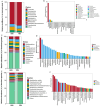Related differences in fecal bacteria of Chinese northern pregnant women of different ages: associations with maternal clinical indicators and neonatal outcomes
- PMID: 40756211
- PMCID: PMC12313554
- DOI: 10.3389/fmicb.2025.1642516
Related differences in fecal bacteria of Chinese northern pregnant women of different ages: associations with maternal clinical indicators and neonatal outcomes
Abstract
The gut microbiota, a vital "microbial organ," influences digestion, immunity, and metabolism. Aging alters gut microbiota of pregnant women through metabolic and hormonal pathways, thereby impacting neonatal health. In this study conducted in northern China, we compared two groups: advanced maternal age (AMA, ≥35 years) and younger maternal age (YMA, 20-34 years), analyzing fecal bacteria and maternal metabolism via biomarker measurements and microbial sequencing. Results showed AMA had significantly higher serum levels of alkaline phosphatase (AKP), 25-hydroxyvitamin D [25(OH)D], and creatinine, while YMA exhibited higher Cu but lower Fe concentrations. Although the fecal bacteria of AMA participants showed greater diversity, the YMA group displayed a more stable bacterial composition, characterized by a higher abundance of beneficial bacteria (e.g., Bifidobacterium) and a lower prevalence of potential pathogens (e.g., Streptococcus). Metabolically, the fecal bacterial network in YMA participants was more integrated, whereas the AMA group showed a "high-complexity, low-efficiency" pattern with disrupted metabolic pathways, which may contribute to adverse pregnancy outcomes. This study highlights age-related dysbiosis of the fecal bacteria in pregnant women and its impact on maternal and neonatal health, advocating for personalized prenatal care strategies for women with AMA.
Keywords: age; clinical indicators; fecal bacteria; microbiota dysbiosis; pregnant women.
Copyright © 2025 Hu, Liu, Sun, Su and Huang.
Conflict of interest statement
The authors declare that the research was conducted in the absence of any commercial or financial relationships that could be construed as a potential conflict of interest.
Figures









Similar articles
-
Maternal and neonatal outcomes in full-term pregnancies of very advanced maternal age: a Japanese single-center retrospective cohort study.BMC Pregnancy Childbirth. 2025 Jul 3;25(1):711. doi: 10.1186/s12884-025-07827-2. BMC Pregnancy Childbirth. 2025. PMID: 40611006 Free PMC article.
-
Integrating Gut Microbiome and Metabolomics with Magnetic Resonance Enterography to Advance Bowel Damage Prediction in Crohn's Disease.J Inflamm Res. 2025 Jun 11;18:7631-7649. doi: 10.2147/JIR.S524671. eCollection 2025. J Inflamm Res. 2025. PMID: 40535353 Free PMC article.
-
Gestational diabetes mellitus alters neonatal gut microbiota and increases infection susceptibility.Front Microbiol. 2025 Jun 23;16:1600325. doi: 10.3389/fmicb.2025.1600325. eCollection 2025. Front Microbiol. 2025. PMID: 40625618 Free PMC article.
-
Incentives for increasing prenatal care use by women in order to improve maternal and neonatal outcomes.Cochrane Database Syst Rev. 2015 Dec 15;2015(12):CD009916. doi: 10.1002/14651858.CD009916.pub2. Cochrane Database Syst Rev. 2015. PMID: 26671418 Free PMC article.
-
Intermittent oral iron supplementation during pregnancy.Cochrane Database Syst Rev. 2015 Oct 19;2015(10):CD009997. doi: 10.1002/14651858.CD009997.pub2. Cochrane Database Syst Rev. 2015. PMID: 26482110 Free PMC article.
References
-
- Acharya A., Shetty S. S. (2024). Role of gut microbiota derived short chain fatty acid metabolites in modulating female reproductive health. Hum. Nutr. Metab. 36:200256. doi: 10.1016/j.hnm.2024.200256 - DOI
-
- Arbib N., Sacks K. N., Salman L., Sneh-Arbib O., Berezowsky A., Krispin E., et al. (2021). Normal distribution of alkaline phosphatase levels during pregnancy. Clin. Exp. Obstet. Gynecol. 48, 1393–1399. doi: 10.31083/j.ceog4806220 - DOI
LinkOut - more resources
Full Text Sources

